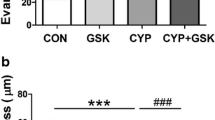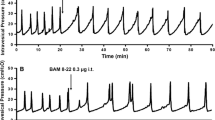Abstract
Purpose
To investigate the effect of intrathecal administration of CCPA, an adenosine A1 receptor agonist, on voiding function in rats with cystitis induced by cyclophosphamide (CYP).
Methods
Thirty 8-week-old Sprague Dawley rats were randomly divided into a control group (n = 15) and a cystitis group (n = 15). Cystitis was induced by a single intraperitoneal injection of CYP (200 mg/kg, dissolved in physiological saline) in rats. Control rats were injected intraperitoneally with physiological saline. The PE10 catheter reached the level of L6-S1 spinal cord through L3-4 intervertebral space for intrathecal injection. Forty-eight hours after intraperitoneal injection, urodynamic tests were conducted to observe the effect of intrathecal administration of 10% dimethylsulfoxide (vehicle) and 1 nmol CCPA on micturition parameters, including basal pressure (BP), threshold pressure (TP), maximal voiding pressure (MVP), intercontraction interval (ICI), voided volume (VV), residual volume (RV), bladder capacity (BC), and voiding efficiency (VE). Histological changes of the bladder of cystitis rats were studied through hematoxylin–eosin staining (HE staining). Moreover, Western blot and immunofluorescence were used to study the expression of adenosine A1 receptor in the L6-S1 dorsal spinal cord in both groups of rats.
Results
HE staining revealed submucosal hemorrhage, edema, and inflammatory cell infiltration in the bladder wall of cystitis rats. The urodynamic test showed significant increase in BP, TP, MVP and RV in cystitis rats, while ICI, VV, BC and VE decreased significantly, indicating bladder overactivity. CCPA inhibited the micturition reflex in both control and cystitis rats, and significantly increased TP, ICI, VV, BC, and VE, but had no significant effect on BP, MVP and RV. Western blot and immunofluorescence showed that there was no significant difference in the expression of adenosine A1 receptor in the L6-S1 dorsal spinal cord between the control and cystitis rats.
Conclusion
The findings of this study suggest that intrathecal administration of the adenosine A1 receptor agonist CCPA alleviates CYP-induced bladder overactivity. Furthermore, our results indicate that the adenosine A1 receptor in the lumbosacral spinal cord may be a promising target for treatment of bladder overactivity.




Similar content being viewed by others
Data availability
The data used and analyzed in this article are available from the corresponding author upon reasonable request.
References
Lin HY, Lu JH, Chuang SM, Chueh KS, Juan TJ, Liu YC, Juan YS (2021) Urinary biomarkers in interstitial cystitis/bladder pain syndrome and its impact on therapeutic outcome. Diagnostics (Basel). https://doi.org/10.3390/diagnostics12010075
Grundy L, Caldwell A, Brierley SM (2018) Mechanisms underlying overactive bladder and interstitial cystitis/painful bladder syndrome. Front Neurosci 12:931. https://doi.org/10.3389/fnins.2018.00931
Yoshikawa S, Oguchi T, Funahashi Y, de Groat WC, Yoshimura N (2012) Glycine transporter type 2 (glyt2) inhibitor ameliorates bladder overactivity and nociceptive behavior in rats. Eur Urol 62(4):704–712. https://doi.org/10.1016/j.eururo.2012.01.044
Ahlmann M, Hempel G (2016) The effect of cyclophosphamide on the immune system: implications for clinical cancer therapy. Cancer Chemother Pharmacol 78(4):661–671. https://doi.org/10.1007/s00280-016-3152-1
Teles KA, Medeiros-Souza P, Lima F, Araujo BG, Lima R (2017) Cyclophosphamide administration routine in autoimmune rheumatic diseases: a review. Rev Bras Reumatol Engl Ed 57(6):596–604. https://doi.org/10.1016/j.rbre.2016.09.008
Dobrek L, Nalik-Iwaniak K, Kopanska M, Arent Z, Thor PJ (2019) Evaluation of selected protein biomarkers of renal function in rats with an experimental model of acute cyclophosphamide-induced cystitis treated with n-acetylcysteine. J Physiol Pharmacol. https://doi.org/10.26402/jpp.2019.5.14
Matz EL, Hsieh MH (2017) Review of advances in uroprotective agents for cyclophosphamide- and ifosfamide-induced hemorrhagic cystitis. Urology 100:16–19. https://doi.org/10.1016/j.urology.2016.07.030
Yang Y, Zhang H, Lu Q, Liu X, Fan Y, Zhu J, Sun B, Zhao J, Dong X, Li L (2021) Suppression of adenosine a(2a) receptors alleviates bladder overactivity and hyperalgesia in cyclophosphamide-induced cystitis by inhibiting trpv1. Biochem Pharmacol 183:114340. https://doi.org/10.1016/j.bcp.2020.114340
Aronsson P, Carlsson T, Winder M, Tobin G (2015) Cyclophosphamide-induced alterations of the micturition reflex in a novel in situ urinary bladder model in the anesthetized rat. Neurourol Urodyn 34(4):375–380. https://doi.org/10.1002/nau.22562
Yu Y, de Groat WC (2008) Sensitization of pelvic afferent nerves in the in vitro rat urinary bladder-pelvic nerve preparation by purinergic agonists and cyclophosphamide pretreatment. Am J Physiol Renal Physiol 294(5):F1146–F1156. https://doi.org/10.1152/ajprenal.00592.2007
Yoshimura N, de Groat WC (1999) Increased excitability of afferent neurons innervating rat urinary bladder after chronic bladder inflammation. J Neurosci 19(11):4644–4653. https://doi.org/10.1523/JNEUROSCI.19-11-04644.1999
Mingin GC, Heppner TJ, Tykocki NR, Erickson CS, Vizzard MA, Nelson MT (2015) Social stress in mice induces urinary bladder overactivity and increases trpv1 channel-dependent afferent nerve activity. Am J Physiol Regul Integr Comp Physiol 309(6):R629–R638. https://doi.org/10.1152/ajpregu.00013.2015
Kitagawa Y, Wada M, Kanehisa T, Miyai A, Usui K, Maekawa M, Sakata M, Matsuo A, Hayashi M, Matsushita M (2013) Jts-653 blocks afferent nerve firing and attenuates bladder overactivity without affecting normal voiding function. J Urol 189(3):1137–1146. https://doi.org/10.1016/j.juro.2012.09.055
Zou S, Shimizu T, Kurabayashi A, Yamamoto M, Shimizu S, Higashi Y, Shimizu N, Karashima T, Saito M (2022) Protective effects of hydrogen sulfide pretreatment on cyclophosphamide-induced bladder dysfunction in rats via suppression of bladder afferent nerves. Nitric Oxide 127:54–63. https://doi.org/10.1016/j.niox.2022.07.004
Wada N, Matsumoto S, Kita M, Watanabe M, Hashizume K, Kakizaki H (2013) Effect of intrathecal administration of e-series prostaglandin 1 receptor antagonist in a cyclophosphamide-induced cystitis rat model. Int J Urol 20(2):235–240. https://doi.org/10.1111/j.1442-2042.2012.03126.x
Chen JF, Lee CF, Chern Y (2014) Adenosine receptor neurobiology: overview. Int Rev Neurobiol 119:1–49. https://doi.org/10.1016/B978-0-12-801022-8.00001-5
Borea PA, Gessi S, Merighi S, Vincenzi F, Varani K (2018) Pharmacology of adenosine receptors: the state of the art. Physiol Rev 98(3):1591–1625. https://doi.org/10.1152/physrev.00049.2017
Li Y, Wu F, Lao LX, Shen XY (2020) Laser irradiation activates spinal adenosine a1 receptor to alleviate osteoarthritis pain in monosodium iodoacetate injected rats. J Integr Neurosci 19(2):295–302. https://doi.org/10.31083/j.jin.2020.02.33
Goldman N, Chen M, Fujita T, Xu Q, Peng W, Liu W, Jensen TK, Pei Y, Wang F, Han X, Chen JF, Schnermann J, Takano T, Bekar L, Tieu K, Nedergaard M (2010) Adenosine a1 receptors mediate local anti-nociceptive effects of acupuncture. Nat Neurosci 13(7):883–888. https://doi.org/10.1038/nn.2562
Kan HW, Chang CH, Lin CL, Lee YC, Hsieh ST, Hsieh YL (2018) Downregulation of adenosine and adenosine a1 receptor contributes to neuropathic pain in resiniferatoxin neuropathy. Pain 159(8):1580–1591. https://doi.org/10.1097/j.pain.0000000000001246
Kitta T, Chancellor MB, de Groat WC, Kuno S, Nonomura K, Yoshimura N (2014) Roles of adenosine a1 and a2a receptors in the control of micturition in rats. Neurourol Urodyn 33(8):1259–1265. https://doi.org/10.1002/nau.22487
Ni J, Cao N, Wang X, Zhan C, Si J, Gu B, Andersson KE (2019) The serotonin (5-hydroxytryptamine) 5-ht(7) receptor is up-regulated in onuf’s nucleus in rats with chronic spinal cord injury. Bju Int 123(4):718–725. https://doi.org/10.1111/bju.14405
Macedo-Junior SJ, Nascimento FP, Luiz-Cerutti M, Santos A (2021) The role of peripheral adenosine receptors in glutamate-induced pain nociceptive behavior. Purinergic Signal 17(2):303–312. https://doi.org/10.1007/s11302-021-09781-y
Kitta T, Chancellor MB, de Groat WC, Kuno S, Nonomura K, Yoshimura N (2012) Suppression of bladder overactivity by adenosine a2a receptor antagonist in a rat model of Parkinson disease. J Urol 187(5):1890–1897. https://doi.org/10.1016/j.juro.2011.12.062
Kitta T, Yabe I, Kanno Y, Higuchi M, Ouchi M, Togo M, Moriya K, Takahashi I, Matsushima M, Sasaki H, Shinohara N (2018) Long-term outcome of adenosine a2a receptor antagonist on lower urinary tract symptoms in male parkinson disease patients. Clin Neuropharmacol 41(3):98–102. https://doi.org/10.1097/WNF.0000000000000281
Fowler CJ, Griffiths D, de Groat WC (2008) The neural control of micturition. Nat Rev Neurosci 9(6):453–466. https://doi.org/10.1038/nrn2401
Juszczak K, Ziomber A, Wyczolkowski M, Thor PJ (2009) Urodynamic effects of the bladder c-fiber afferent activity modulation in chronic model of overactive bladder in rats. J Physiol Pharmacol 60(4):85–91
Honda M, Yoshimura N, Kawamoto B, Kobayashi N, Hikita K, Muraoka K, Saito M, Sejima T, Chancellor MB, Takenaka A (2014) Effects of sensory neuron-specific receptor agonist on bladder function in a rat model of cystitis induced by cyclophosphamide. Int Urol Nephrol 46(10):1953–1959. https://doi.org/10.1007/s11255-014-0734-x
Tsukimi Y, Mizuyachi K, Matsumoto H, Sato M, Ng B, Tajimi M (2004) Mechanism of action by which aspirin alleviates detrusor hyperactivity in rats. J Pharmacol Sci 95(1):101–107. https://doi.org/10.1254/jphs.95.101
Reeve AJ, Dickenson AH (1995) The roles of spinal adenosine receptors in the control of acute and more persistent nociceptive responses of dorsal horn neurones in the anaesthetized rat. Br J Pharmacol 116(4):2221–2228. https://doi.org/10.1111/j.1476-5381.1995.tb15057.x
Imlach WL, Bhola RF, May LT, Christopoulos A, Christie MJ (2015) A positive allosteric modulator of the adenosine a1 receptor selectively inhibits primary afferent synaptic transmission in a neuropathic pain model. Mol Pharmacol 88(3):460–468. https://doi.org/10.1124/mol.115.099499
Miyazato M, Yoshimura N, Nishijima S, Sugaya K (2009) Roles of glycinergic and gamma-aminobutyric-ergic mechanisms in the micturition reflex in rats. Low Urin Tract Symptoms 1(S1):S70–S73. https://doi.org/10.1111/j.1757-5672.2009.00034.x
Bai HH, Liu JP, Yang L, Zhao JY, Suo ZW, Yang X, Hu XD (2017) Adenosine a1 receptor potentiated glycinergic transmission in spinal cord dorsal horn of rats after peripheral inflammation. Neuropharmacology 126:158–167. https://doi.org/10.1016/j.neuropharm.2017.09.001
Diao XT, Yao L, Ma JJ, Zhang TY, Bai HH, Suo ZW, Yang X, Hu XD (2020) Analgesic action of adenosine a1 receptor involves the dephosphorylation of glycine receptor alpha1(ins) subunit in spinal dorsal horn of mice. Neuropharmacology 176:108219. https://doi.org/10.1016/j.neuropharm.2020.108219
Metzner K, Gross T, Balzulat A, Wack G, Lu R, Schmidtko A (2021) Lack of efficacy of a partial adenosine a1 receptor agonist in neuropathic pain models in mice. Purinergic Signal 17(3):503–514. https://doi.org/10.1007/s11302-021-09806-6
Romagnoli R, Baraldi PG, Tabrizi MA, Gessi S, Borea PA, Merighi S (2010) Allosteric enhancers of a1 adenosine receptors: state of the art and new horizons for drug development. Curr Med Chem 17(30):3488–3502. https://doi.org/10.2174/092986710792927831
Funding
Project of Shanghai Municipal Commission of Health and Family Planning, 20174011, Zhong Chen.
Author information
Authors and Affiliations
Contributions
ZC and BG designed the experiment. LZ and XC performed the experiment. ML and RL helped to perform the experiment. LZ wrote the manuscript. ZC and BG revised the manuscript. All authors read and approved the final manuscript.
Corresponding authors
Ethics declarations
Conflict of interest
There is no conflict of interest related to this article among authors.
Additional information
Publisher's Note
Springer Nature remains neutral with regard to jurisdictional claims in published maps and institutional affiliations.
Rights and permissions
Springer Nature or its licensor (e.g. a society or other partner) holds exclusive rights to this article under a publishing agreement with the author(s) or other rightsholder(s); author self-archiving of the accepted manuscript version of this article is solely governed by the terms of such publishing agreement and applicable law.
About this article
Cite this article
Zhang, L., Chen, X., Li, M. et al. Activation of the adenosine A1 receptor in the lumbosacral spinal cord improves bladder overactivity in rats with cystitis induced by cyclophosphamide. Int Urol Nephrol 55, 2183–2191 (2023). https://doi.org/10.1007/s11255-023-03659-1
Received:
Accepted:
Published:
Issue Date:
DOI: https://doi.org/10.1007/s11255-023-03659-1




